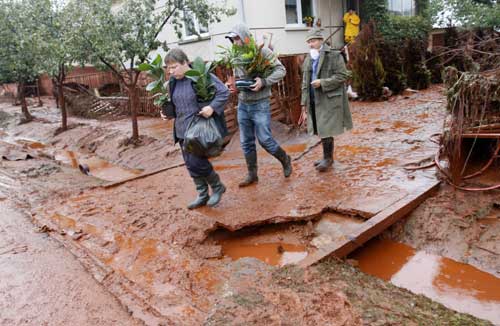Global General
Hungary sludge flood called 'ecological disaster'
(China Daily)
Updated: 2010-10-07 09:50
 |
Large Medium Small |
KOLONTAR, Hungary - A lethal torrent of toxic red sludge from a metal refinery engulfed towns in Hungary, burning villagers through their clothes and threatening an ecological disaster on Tuesday as it swept toward the Danube River.
The flood of caustic red mud triggered a emergency declaration by Hungarian officials. At least four people were killed, six were missing and 120 injured, many with burns.
Hundreds were evacuated in the aftermath of the disaster on Monday, when a gigantic sludge reservoir burst its banks at an alumina plant in Ajka, a town 160 km southwest of Budapest, the capital. The torrent of sludge inundated homes, swept cars off roads and damaged bridges.
Named for its bright red color, the material is a waste compound in alumina production that contains heavy metals and is toxic if ingested.
In Kolontar, the town closest to the plant, Erzsebet Veingartner was in her kitchen when the 3.6-meter-high wave of red slurry hit, sweeping away everything in its path.
"I looked outside and all I saw was the stream swelling like a huge wave," the 61-year-old widow said on Tuesday as she surveyed her backyard, still under 1.8 meters of noxious muck.
"I lost all my chickens, my ducks, my Rottweiler, and my potato patch. My late husband's tools and machinery were in the shed and it's all gone," sobbed the woman, who gets by on a $350 monthly pension. "I have a winter's worth of firewood in the basement and it's all useless now."
Emergency workers wearing masks and chemical protection gear rushed to pour 1,000 tons of plaster into the Marcal River in an attempt to bind the sludge and keep it from flowing on to the Danube some 72 km away. Nearby, desperate villagers waded through the toxic mud trying to salvage possessions with little more than rubber gloves as protection.
The 2,850 km Danube passes through some of the continent's most pristine vistas from its origins as a Black Forest spring in Germany to its end point as a majestic stretch of water emptying into the Black Sea.
Now a murky green - not blue as immortalized in the Strauss waltz - the river flows through four former communist nations. One of the continent's greatest treasuries of wildlife, it has been the focus of a multibillion dollar post-communist cleanup. Cormorants, swans and other birds are now common sights on the river.
Still, high-risk industries such as Hungary's Ajkai Timfoldgyar alumina plant are still producing waste near some of its tributaries, posing a threat to the waterway.
By Tuesday, 1 million cubic meters of sludge had poured from the reservoir, flooding a 40 sq km area, Environmental Affairs State Secretary Zoltan Illes told the state news wire MTI. He called the spill an "ecological catastrophe."
Dozens of villagers were burned when the caustic material seeped through their clothing. Two women, a young man and a 3-year-old child were killed, and health officials said two of the injured were in critical condition.
Because chemical burns can take days to emerge, superficial injuries can turn deadly as they penetrate deeper tissue.
Robert Kis said his uncle was flown by helicopter to Budapest after the sludge "burned him to the bone," but he was grateful the family's pet rabbit and cat were safe.
Firefighters and soldiers wearing masks, rubber boots and other protective gear waded through the stricken area on Tuesday, flushing away the sludge with hoses, aided by dozens of bulldozers, their loaders scraping the polluted ground.
Hungarian Prime Minister Viktor Orban said that authorities were caught off guard by the disaster, telling reporters the alumina plant and reservoir had been inspected two weeks earlier and no irregularities had been found.
Red sludge is a byproduct of the refining of bauxite into alumina, the basic material for manufacturing alumina. Representatives from industry organizations in the United States and London could not explain why the Hungarian victims were burned by the material.
The company, meanwhile, denied that it should have taken more precautions to shore up the reservoir - a huge structure more than 300 meters long and 450 meters wide, and high enough to dwarf trees that survived the torrent.
Associated Press
